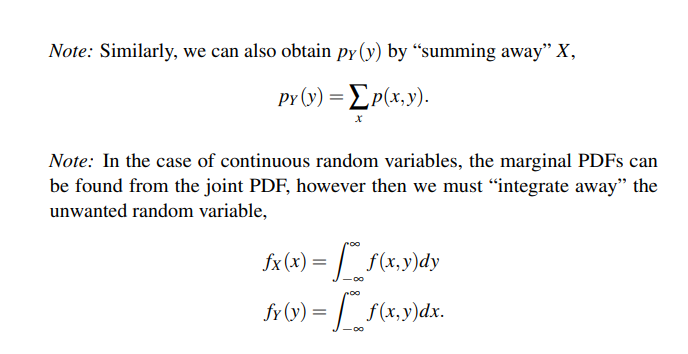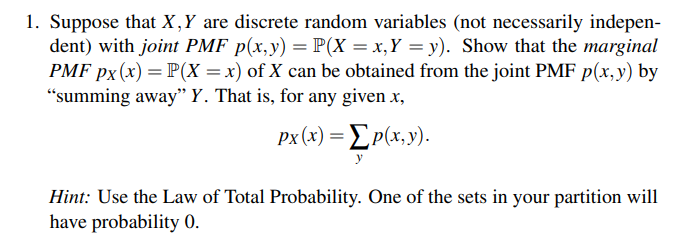1. Suppose that X, Y are discrete random variables (not necessarily indepen- dent) with joint PMF p(x,y) = P(X = x, Y = y). Show that the marginal PMF px(x) = P(X = x) of X can be obtained from the joint PMF p(x, y) by "summing away" Y. That is, for any given x, px (x) = [p(x,y). Hint: Use the Law of Total Probability. One of the sets in your partition will have probability 0.
1. Suppose that X, Y are discrete random variables (not necessarily indepen- dent) with joint PMF p(x,y) = P(X = x, Y = y). Show that the marginal PMF px(x) = P(X = x) of X can be obtained from the joint PMF p(x, y) by "summing away" Y. That is, for any given x, px (x) = [p(x,y). Hint: Use the Law of Total Probability. One of the sets in your partition will have probability 0.
Algebra & Trigonometry with Analytic Geometry
13th Edition
ISBN:9781133382119
Author:Swokowski
Publisher:Swokowski
Chapter10: Sequences, Series, And Probability
Section10.8: Probability
Problem 32E
Related questions
Question
1

Transcribed Image Text:Note: Similarly, we can also obtain py(y) by "summing away" X,
PY (y) = [p(x,y).
X
Note: In the case of continuous random variables, the marginal PDFs can
be found from the joint PDF, however then we must "integrate away" the
unwanted random variable,
fx (x) =
f(x,y)dy
fy (y) =
f(x,y)dx.

Transcribed Image Text:1. Suppose that X,Y are discrete random variables (not necessarily indepen-
dent) with joint PMF p(x,y) = P(X= x, Y = y). Show that the marginal
PMF px(x) = P(X=x) of X can be obtained from the joint PMF p(x,y) by
"summing away" Y. That is, for any given x,
px (x) = [p(x,y).
Hint: Use the Law of Total Probability. One of the sets in your partition will
have probability 0.
Expert Solution
This question has been solved!
Explore an expertly crafted, step-by-step solution for a thorough understanding of key concepts.
This is a popular solution!
Trending now
This is a popular solution!
Step by step
Solved in 2 steps with 1 images

Recommended textbooks for you

Algebra & Trigonometry with Analytic Geometry
Algebra
ISBN:
9781133382119
Author:
Swokowski
Publisher:
Cengage

Algebra & Trigonometry with Analytic Geometry
Algebra
ISBN:
9781133382119
Author:
Swokowski
Publisher:
Cengage